Content
- 1 Let's start by storing hyacinth bulbs at home:
- 2 Planting hyacinths at home
- 3 Planting hyacinth in the ground at home
- 4 Hyacinth at home after flowering
- 5 Forcing hyacinths at home
- 6 How to choose bulbs
- 7 How to prepare hyacinth bulbs for distillation?
- 8 What to do with hyacinth after flowering?
- 9 Breeding hyacinths
- 10 Is it possible to grow Hyacinth as a houseplant
- 11 Planting and soil
- 12 Location
- 13 Watering
- 14 Problems
Hyacinth is a flowering bulbous plant that can be grown not only in the garden, but also at home. The flowers of this plant resemble bells that grow in lush bunches. The flower not only looks beautiful, but also has a delicate aroma. Of course, outdoor hyacinths bloom in spring, but they can be tricked into blooming at home in winter. If you store the bulbs properly and then provide proper hyacinth care at home, you can effortlessly enjoy its bloom from December to April. And now, in detail about how to grow hyacinth at home: how to store bulbs at home, two ways to plant hyacinth in water and soil, how to care for hyacinth at home and what to do with hyacinth after flowering.
Let's start by storing hyacinth bulbs at home:
Bulbs need a moist and cool place to store them. After purchasing, you can store them for up to 8-10 weeks in a sandbox on the balcony or in a paper (not plastic bag!) Bag at the bottom of the refrigerator. But be very careful - do not place the bag next to vegetables and fruits, as they emit ethylene gas, which can damage the bulbs. Check the bulbs periodically to keep them from drying out.
Note!Hyacinth bulbs are poisonous, so make sure children cannot reach them. They also contain oxalic acid, which can irritate the skin. Therefore, before planting, thoroughly moisten the bulbs to reduce the effects of oxalic acid, and wear gloves for protection.
Planting hyacinths at home
There are several methods for forcing hyacinths. I will tell you about two: growing hyacinths in special glass vases with water and about the classic cultivation in a pot with soil.
Growing hyacinth in water
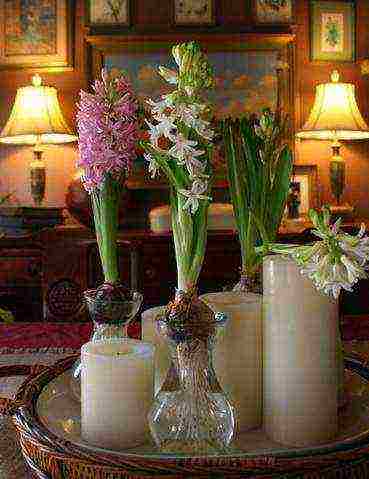
- Choose suitable containers, with a narrow bottom and wide top so that the bulbs are above the water and only the roots are in contact with the water.
- Place the onion on the wide side and pour warm water on the bottom. Change the water to fresh water once or twice a week.
- Place the bulbs in a dark and cool place (4-10 degrees Celsius) until roots begin to grow and leaves appear. Basements and garages are ideal for this. These pre-chilled hyacinths will grow in about 3 to 4 weeks, compared to 8 to 16 weeks with a typical planting.
- Further hyacinth care at home is simple. After the leaves begin to develop, move the bulbs to a warmer area (18 degrees) and well lit. A sunny window is optimal, but not in direct sunlight. Hyacinth is picky about sunlight. If he lacks light, then he will bloom for a short time, and you will not even have time to stop looking.
- Rotate containers daily and change water regularly. After two weeks, you will enjoy the hyacinth blooming at home.These gorgeous, scented flowers will delight you for another two to three weeks if they are kept in a cool place.
- After the hyacinth has faded, the bulbs must be discarded. Since, when grown in water, the bulbs consume their food and energy reserves so much that they will not bloom again.
Planting hyacinth in the ground at home

Use 20 cm pots with drainage holes. If they have been used before, rinse them thoroughly. If you are using clay pots, soak them in a bucket of water overnight to prevent them from picking up moisture from the planting soil. Prepare the soil for planting hyacinths from equal parts of sod or leafy soil, compost, peat and sand.
Important! Do not add any fertilizer to the soil!
- Place soil on the bottom of the container, then place three or four onions in a 20 cm pot, or one in a 10-12 cm pot. The top of the bulb should be visible above the soil surface. Do not fill the pot with soil to the brim - leave room for watering.
- After planting, the pot should be placed in a dark and cool place with a temperature of 2 - 8 degrees. This can be a refrigerator or a garage (basement). Keep the soil moist throughout the rooting and cooling period. After five to six weeks, roots will begin to grow from the holes of the containers, and shoots will begin to sprout from the top of the bulb.
- After 10 to 13 weeks of cold processing, the bulbs can be transferred to the home. For continuous flowering of hyacinths at home, fill as many pots as you can in a cool place during cold working, and then bring several pots into the house at weekly intervals.
Further hyacinth care at home will be as follows:
- Place the pots in a dim light at 15 degrees for a week or two until the yellow sprouts at the top of the bulb turn green.
- Then move the hyacinths to a lighter and warmer place, such as a windowsill. But avoid direct sunlight and rotate the pots every day to avoid twisting the stems.
- After the buds open, move the plant to a cooler place without direct sunlight to prolong the blooming of the hyacinth at home. You can put flower pots in beautiful places during the day, decorating the house, and transfer them to the coldest room at night. These will extend the flowering time of the hyacinths.
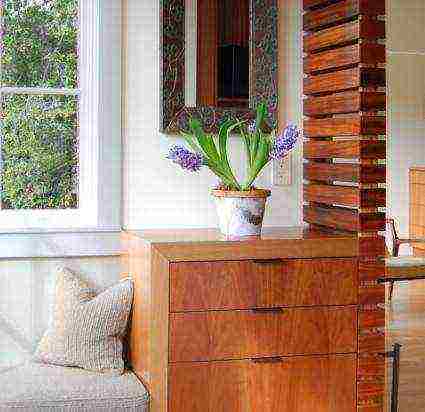
Hyacinth at home after flowering
As already mentioned, when growing hyacinths in water, the bulbs consume too much energy, so they do not bloom again. When hyacinths are planted in the ground, the bulbs can bloom again, although this bloom will no longer be as abundant. Therefore, you have two ways:
- you can throw away the bulbs
- Transplant them outdoors. After the plant has bloomed and turned brown, cut off the stems at the base, but still care for the hyacinth, provide it with regular watering. And in the spring, plant them in open ground, where the plants will recover and bloom again, although not necessarily this year or not so beautiful. But if you do not have a garden, then at home you will not be able to save the bulbs until the next planting, so throw them away and buy new ones next year.
There is nothing difficult in growing and caring for a hyacinth. Most importantly, follow the tips above. And then your flower will bloom and will delight you for a long time.

In winter, when it is so cold outside the window, I especially want the smell of spring in the house. And to achieve this is quite simple - you just have to settle a hyacinth on the windowsill. This bright and very fragrant plant is also remarkable because its flowering can be tailored to any desired date. Growing hyacinths at home will be discussed in our article.
How to grow hyacinths at home?
Many of us are not sure if it is possible to keep hyacinths at home? Of course you can - this initially wild plant grows well not only in the garden, but also on the windowsill, you just need to create the necessary growing conditions for the hyacinth and strictly follow all agricultural techniques.
Stage 1 - Seed Selection
To grow a handsome hyacinth at home, the first thing you need is a strong healthy bulb, at least 5 cm in girth. It is this kind of seed that is needed to get a strong plant with a strong peduncle. It is best to buy hyacinth bulbs from trusted flower shops, where they are most likely stored in the right conditions.
Stage 2 - planting hyacinth
You can grow hyacinth at home both in a regular pot and in water. In the first case, a small pot (10-12 cm in diameter) is needed for the hyacinth. You can also plant several bulbs in one container so that the distance between them is at least 3 cm. Do not allow the bulbs to touch the pot walls. A thick layer of drainage is laid at the bottom of the pot, then a layer of soil mixture is poured. Any soil mixture for growing hyacinth can be used, as long as its acidity is not too high. A layer of sand is spread on top of the soil mixture, then the bulb is placed and lightly pressed into the pot. As a result, the bulb should rise at least 1/3 above the soil layer.
In the case of aquatic cultivation, hyacinth is placed in a narrow container with a nutrient solution (water + fertilizer) so that it touches the liquid only at the bottom.
Stage 3 - forcing the hyacinth
Whichever method of growing hyacinth is chosen, it must go through such a stage of development as a dormant period - the bulb planted in the ground or water is sent to a dark and cold (+ 5 ... + 7 ° C) room, where it will slowly germinate throughout 2-2.5 months. Only after the leaves hatch from the bulb, it is transferred to a room with a higher temperature (+10 .. + 15 ° С). If you do not wait for the leaves to appear and bring the bulb into the heat earlier, and even put it under good lighting, you can not wait for the hyacinth to bloom at all.
Stage 4 - leaving
Now let's take a closer look at how to care for a hyacinth at home during the growth period. After the pot with the hatched onion has been removed from the cold, it is moved to a bright and warm (+ 15 ° C) room. In these conditions, the hyacinth will remain until the moment it releases an arrow with buds. After the appearance of the long-awaited buds, the hyacinth can be sent to the place chosen for it - a window sill or a table, placing it away from drafts and the heat of heating appliances. 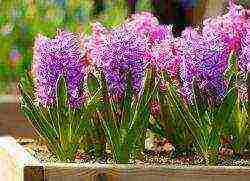 During the flowering period, you need to care for the hyacinth in no other way than by regularly watering it. Watering the hyacinth should be extremely careful not to let the water get on the leaves or bulb. Periodically, the hyacinth is rotated around its axis to evenly illuminate it.
During the flowering period, you need to care for the hyacinth in no other way than by regularly watering it. Watering the hyacinth should be extremely careful not to let the water get on the leaves or bulb. Periodically, the hyacinth is rotated around its axis to evenly illuminate it.
Stage 5 - care of faded hyacinth
After the end of the flowering of the hyacinth, the peduncle must be carefully cut off and continue caring for the plant until the leaves wither. Although the forced bulb is not able to bloom a second time, it can be used for propagation. To do this, the bulb is carefully removed from the pot in order to plant it in the open ground in the fall. There, in the wild, she will successfully give birth to offspring.
Hyacinth (Hyacinthus) is a beautifully flowering bulbous plant in spring. It belongs to the Asparagaceae family, according to some sources - Liliaceae and is better known as a perennial garden plant.
Hyacinths are often grown at home. They are used mainly for forcing. Long blooming, with a pleasant aroma, plants delight with their delicate spring beauty in the middle of winter.
The height of the plant is no more than 20-25 cm, the leaves are fleshy, elongated. The hyacinth bulb is dense, 5-6 cm in diameter, lives a long time (sometimes up to 10 years).
The peduncle is fleshy, leafless, there are more than thirty bell-shaped flowers on it. Each hyacinth bulb usually produces one peduncle. Flowers last for two to three weeks. They come in all kinds of colors - white, cream, red, pink, blue and lilac, blue-violet. There are terry forms and varieties with variegated colors of flowers.
When forcing hyacinths, the general rules for forcing bulbous plants should be followed. It is also good to know that hyacinth bulbs contain oxalic acid, so treating them can cause mild irritation in people with sensitive skin.
Forcing hyacinths at home
Forcing plants is an agrotechnical technique, with the help of which plants are artificially brought out of dormancy, accelerate its growth and make it bloom and bear fruit at an unusual time for culture. For forcing, the bulbs must be selected and prepared correctly.
How to choose bulbs
For distillation, large, dense, well-ripened bulbs are acquired. Plants must be pre-grown outdoors. There should be no damage to them and the bulb itself should be heavy.
How to prepare hyacinth bulbs for distillation?
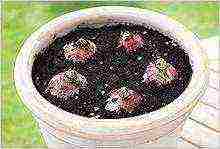
Hyacinth bulbs in mid or late autumn (depending on the planned flowering time) are planted in pots filled with loose earth so that the top of the bulb is flush with the edges of the pot. When placing several bulbs in one container, keep the distance between the bulbs - it should be about 2.5 cm. The substrate can be prepared from leafy earth, sand and add crushed charcoal. The bulb itself is not completely covered with earth, about a third of it should be on the surface.
Pots with planted hyacinth bulbs are covered with inverted pots, paper caps, dark plastic with holes for ventilation. Sometimes they are covered with a layer of peat crumb or sawdust. In this way, the prepared plants are transferred to a dark, cool place, where they are kept for 10-12 weeks at a temperature of 5-8 degrees. It is a "winter" for hyacinths, and it should last for a certain amount of time. During this period, plants are sometimes watered with cold water only as the earth dries out. The soil should be slightly damp, but not wet.
During this time, hyacinths usually develop sprouts. The shelter is removed, the pots are transferred to a bright room with a temperature of 20-23 degrees. It is advisable to transfer it not immediately to warmth and the sun, but first for acclimatization in a cool shaded room for several days, and then in a warm one.
Watering regularly, it is helpful to feed the plant with complex mineral approval. Blooming hyacinths at home occurs 3-4 weeks after transferring to light and lasts up to three weeks. To prolong flowering, it is advisable to place the pot with the plant in a cooler room.
Hyacinths are also grown in water in graceful transparent vessels without any soil. A mixture of mineral fertilizers is dissolved in soft water (rain or melted snow). The bulb is placed so that it hardly touches the water. The vase is taken to a dark, cool place and water is added every 2 weeks. Hyacinths take many roots, and when transferred to a bright room, they begin to bloom.
What to do with hyacinth after flowering?
Used bulbs do not bloom next year, they are often simply thrown away. It is best to plant them in the garden, then after 2 years they can be used again for forcing. Not all varieties of hyacinths can tolerate severe frosty winters. It is advisable to cover the bulbs with fallen leaves or sawdust.
But the problem is that hyacinths bloom at home in winter or early spring, there is simply nowhere to transplant them - there is still snow everywhere, the ground is frozen.
In the literature, they are recommended to be stored dry (in a pot, peat crumb or sawdust) until autumn, then planted in the ground. But such bulbs most often simply dry up, it is difficult to preserve them. They cannot withstand dry storage from February-March to autumn. In addition, if they survive, they will not bloom next year.

Under normal home conditions, the easiest way to save hyacinth is to cut off the faded peduncle and water it a little. If the hyacinth is blooming in a small pot, it is best to carefully transfer it to a larger pot. Pour a drainage layer at the bottom, the soil should be loose, you can add sand to any purchased land. Water in moderation, place in a bright, cool place, care for as a normal houseplant. The hyacinth will have new leaves, it will develop like its usual garden relatives. In late spring, transplant into open ground, without deepening the neck of the bulb.
What hyacinths can accumulate enough nutrients in the bulb to bloom next year. They may develop daughter bulbs.
Breeding hyacinths
Hyacinths can be propagated by seeds and bulbs. Seeds are bred by experts to obtain new varieties. A flowering bulb is obtained from a seed not earlier than after 5 years.
Hyacinths planted in open ground easily produce daughter bulbs. They inherit all parent properties.
Hyacinth is one of the most beautiful plants. It is also popularly called the "rain flower". It is a favorite of gardeners, as the flowers of this plant are the very first to bloom. This plant has a wonderful smell and a wide range of colors. Hyacinth is a bulbous plant, belongs to the “hyacinth” family. One of its advantages is its versatility. Hyacinths are suitable for both open field, indoor cultivation and cutting.
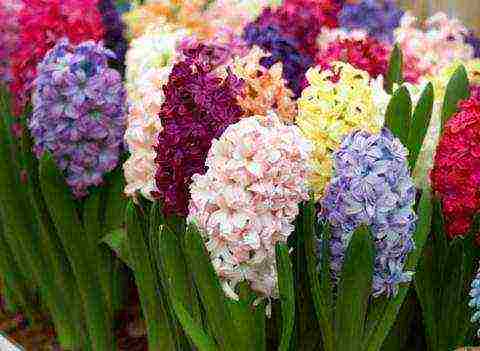
Distinguish between early, middle and late varieties. The first to bloom are those flowers that have a darker color, for example, blue. The latest to appear are orange and yellow flowers. The bulb of our flower reaches a rather large diameter (6 centimeters). Hyacinth is considered a garden plant, so if you want to grow it at home, you should try and create as close as possible outdoor conditions so that your flower does not die. To plant the Hyacinth at home, you need bulbs with a diameter of at least 5 centimeters that have passed the summer "hibernation" period.
Is it possible to grow Hyacinth as a houseplant
Hyacinth, unfortunately, cannot live long in a pot. The bulbs of this flower are used for forcing (the use of a special set of measures to accelerate plant growth). This is an artificial method that depletes the flower bulbs, because of this, the strength of the bulb will not be enough for the plant to bloom again. Therefore, after distillation, it is recommended to give rest to the mother bulbs by planting them in open ground for 1-2 years.
Planting and soil
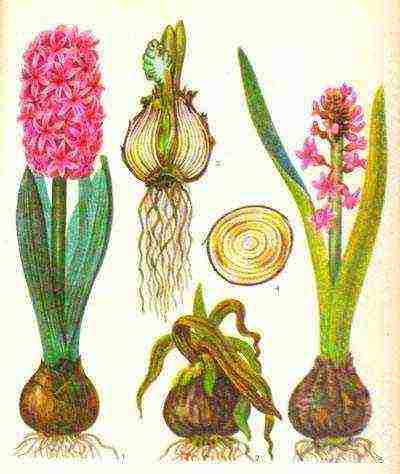
Plant 1 to 3 bulbs in a pot. The distance between them should be 2-2.5 centimeters. If you plant one onion, then select the pot according to its size.
A prerequisite for flower growth is that the bulb sits close.
Install drainage at the bottom of the pot (you can use sand, the layer should be 2-3 centimeters). The soil should be composed of sand and peat, or compost and sand. You should not completely submerge the bulb in the soil, its tip should stick out above the ground (⅓ part).
Cover the substrate with sand (1 centimeter) to prevent decay.
For watering after planting, use a 0.2% calcium nitrate solution. Place the onion pots in a cool dark room for 6 weeks in which the temperature will be at least 5 degrees, but not higher than 9 degrees (you can put it in the refrigerator, but not in the freezer). Such measures are applied to recreate conditions such as in the fall in the garden. Check the ground, make sure that it is not dry.When the shoots rise to 3-5 centimeters, take the pots with shoots into the room, but make sure that the temperature in the room does not exceed 12 degrees. Place the shoots in a dark place for several weeks, then you can move the pots closer to the light (when the shoots have reached 10 centimeters).
As soon as the first flowers appear on the plant, place it in its permanent "residence".
Location

Hyacinths love well-lit places. Place the flower away from the battery, away from drafts. The air temperature should be no higher than 20 degrees. Make sure that the soil does not dry out, add liquid top dressing.
Watering
These flowers love moist soil, but water stagnation should not be allowed, this requires a drainage layer, and the water that stagnates must be drained. Pour water into the tray, as getting liquid on bulbs, flowers, leaves is not recommended. With an air humidity of 80-90 percent, watering may not be required at all during the early forcing of the bulb, with one watering at average, and two watering at a later one.
Reproduction
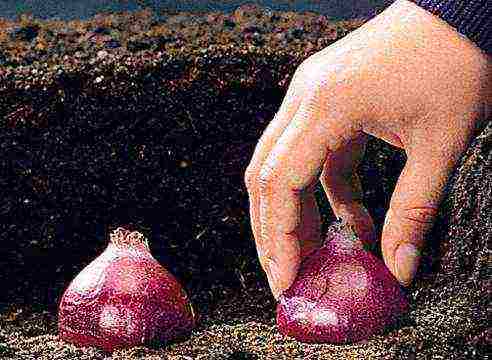
The “cubs” are separated before the dormancy of the plant. Separation is possible only if the flowers are easily removed from the mother plant. Before the procedure, the bulb from which you are going to separate is dried for several days. Young bulbs are planted in open ground (they are not used for forcing). They will begin to bloom only after 3-4 years. If the “babies” do not separate, then plant the mother bulb with the “babies”.
Problems
The actual problem for Hyacinth is a short peduncle. This may be due to:
- the temperature regime was violated at the time when you stored the bulbs
- beginning of bulb decay
- during the period when the bulbs were in the refrigerator, the soil was allowed to dry out.
Hyacinth is a very beautiful flower, but unfortunately, after flowering, you will have to part with these bulbs, since they are not used for re-forcing.
However, don't forget that you can plant these bulbs outdoors and they will delight you with their gorgeous flowers again.
To do this, save obsolete bulbs until autumn planting. After cutting the flowers, feed and water the flowers until the leaves wither. After that, free the bulbs from the pot, dry them, remove the dead sprouts and hide them in a dry place. When the time comes, plant them in the open air.


